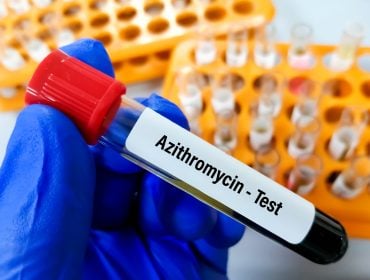Gonorrhea: Definition, Symptoms, & Testing Information
Gonorrhea is a bacterial sexually transmitted disease that is caused by Neisseria gonorrhoeae. It is a common STD that is contracted during vaginal, anal or oral sex. It can also be spread by sharing unclean sex toys. According to the Centers for Disease Control and Prevention (CDC), there were approximately 486,514 cases reported in 2016 in the United States. The actual number of cases is assumed to be higher since this STD is often asymptomatic. The CDC estimates that more than 800,000 new gonorrhea cases occur annually in the United States.

Gonorrhea is also commonly called “The Clap” or “The Drip”, due to the yellow/green penile discharge seen with infection. However, most people with gonorrhea do not show any signs or symptoms of infection, which is why it is so important to get tested for this infection. Asymptomatic cases are often spread since those infected do not realize they have it. If symptoms appear, they typically occur within 2-21 days after exposure to the STD.
Gonorrhea most frequently infects the cervix, urethra or rectum, but can also be spread to the throat during oral sex. The infection can spread to the eye if an infected area is touched and then the eye is touched.
Pregnant women with gonorrhea can pass the infection to their babies during childbirth. It is especially harmful to infants and can cause blindness and or serious joint and blood infections that may result in death.
What are the top symptoms of gonorrhea?
Symptoms of gonorrhea sometimes differ between men and women. Gonorrhea is frequently asymptomatic.
Symptoms in men can include:
Secure and Confidential
STD testing services
The fastest results possbile - available in 1 to 2 days
- Green or yellow discharge from the penis
- Burning/itching sensation during urination
- Urgency or need to urinate more frequently
- Pain/swelling in one or both testicles (less common)
- Swollen and/or red urethra and tip of penis
Symptoms in women can include:
- Abnormal vaginal discharge
- Burning sensation or pain during urination
- Increased urination
- Pain during intercourse (less common)
- Abdominal pain (less common)
- Fever can occur if infection spreads to upper genital tract
For both men and women, symptoms of a gonorrhea rectal infection may include rectal pain or bleeding. A sore throat can indicate a gonorrhea infection of the throat. If a gonorrhea infection spreads to the blood, it can cause rashes, arthritis-like pain and/or a fever and this infection can be life-threatening.
Who is at risk for contracting gonorrhea?
This STD is particularly common in young people ages 15-24 years. The CDC estimates that 5 out of 8 cases are from people in this age group. According to a CDC report, the gonorrhea rate for women is slightly higher than for men. Like chlamydia, gonorrhea is more prevalent among young women because their cervixes are still developing and are more susceptible to the bacteria. Women also have more surface area for the bacteria to infect, making it easier for gonorrhea to be contracted.
Gonorrhea often occurs alongside chlamydia (another bacterial STD). If you have one of these STDs, you might have the other because the risk factors are very similar. Getting tested for both chlamydia and gonorrhea is important.

Whether symptoms are present or not, untreated gonorrhea can cause serious health problems. In women, untreated gonorrhea can lead to scarring of the Fallopian tubes causing permanent damage leading to infertility or potentially fatal ectopic pregnancy or miscarriage. In men, untreated cases can lead to epididymitis, which can, but very rarely does, cause sterility. Gonorrhea can also cause scarring of the urethra in men.
Can gonorrhea be cured?
Gonorrhea can be treated and cured with antibiotics. Individuals diagnosed with gonorrhea should abstain from sexual activity for one week upon finishing antibiotics. You can become infected with gonorrhea again after being cured. It is crucial for partners of those who have gonorrhea to also get tested to allow treatment when tests are positive.
Whether or not symptoms are present, testing or screening for gonorrhea can be done as early as two days after exposure. The incubation times vary from person-to-person; for the most accurate results, get tested two weeks after initial exposure. If you test positive for gonorrhea, it is advised to get retested two weeks after completing treatment to be sure that all of the Neisseria gonorrhoeae bacteria is cleared from your system.
How do you test for gonorrhea?
Nucleic Acid Amplification (NAA)
- These NAA tests find the DNA of gonorrhea bacteria. Because it searches for the bacteria’s genetic material, it is very unlikely that a false-positive test result will occur. Often, the gonorrhea NAA test is a urine test.
Urine samples (recommended test method)
- Urine samples should consist of first-catch urine (approximately 20 to 30 mL of the initial urine stream). This means collecting the very first part of the urine sample. Typically, patients should not include more than the first-catch in the collection cup to avoid diluting the sample.
- Patients should not urinate for at least one hour prior to providing a sample.

- Female patients should not cleanse the labial area prior to providing the specimen.
Swab cultures
- Endocervical swab (women)
- Male urethral swab
- Vaginal swab
- Rectal swab
- Pharyngeal swab
Gram Stain
- Swab cultures from eye; used to detect Neisseria gonorrhoeae infection of the eye.
Blood Samples
A small blood sample is drawn and then tested for antibodies to Neisseria gonorrhoeae. Gonorrhea very rarely passes into the bloodstream. The body creates antibodies to respond to various diseases and infections, and these can be found in the blood. These tests can result in a false-positive, and cannot tell for certain that an individual has gonorrhea at the time of the test, but can tell whether or not the individual has had it in the past. This type of test should not be used to diagnose gonorrhea.
Enzyme-linked immunosorbent assay (ELISA); Antibodies, IgM
- IgM antibodies are found mainly in the blood and lymph fluid; they are the first antibody to be made by the body to fight a new infection.
- This blood sample’s results should not be used as a diagnostic procedure without confirmation of the diagnosis by another medically established diagnostic product or procedure.
- Enzyme immunoassay (EIA); Antibodies, IgG
- IgG antibodies are the most abundant type of antibody; they are found in all body fluids and protect against bacterial and viral infections.
Gonorrhea Culture
Secure and Confidential
STD testing services
The fastest results possbile - available in 1 to 2 days
- Culture of a sample of body fluid, discharge, pus, swab of genital lesions, or urethral discharge (best for men when available).
- Women should not douche or use vaginal creams/medicines for 24 hours before having a gonorrhea test.
- Cultures are rarely taken of blood or joint fluid.
- Confirmed diagnosis can be confirmed after 72 hours.
- Test options for cell cultures include:
- Endocervical swab
- Rectal swab
- Posterior nasopharynx/throat swab
- Male urethral swab
Antibiotic-resistant gonorrhea cases are becoming more common. According to the CDC, “Gonorrhea has progressively developed resistance to the antibiotic drugs prescribed to treat it. Following the spread of gonococcal fluoroquinolone resistance, the cephalosporin antibiotics have been the foundation of recommended treatment for gonorrhea.”
It is important to finish all rounds of antibiotic prescribed to treat gonorrhea, and to get retested upon finishing antibiotics to be sure that all of the Neisseria gonorrhoeae bacteria has been eradicated from the body. It is important to get sexual partners treated also to prevent reinfection and to either abstain from sex while taking these antibiotics or to use condoms during sex while being treated.
Key Takeaways:
- Gonorrhea is a very common bacterial STD in the United States.
- Gonorrhea is a curable STD that doesn’t usually show signs or symptoms.
- Gonorrhea can cause infertility in women and sterility in men if left untreated.
- Gonorrhea can be transmitted to newborns during delivery and cause serious health complications including blindness and even death.
- Gonorrhea is particularly common in young people (aged 14-24) and is especially prevalent among young women.
- Co-infection of gonorrhea and chlamydia is common.
- Gonorrhea can infect the genitals, rectum, throat and eyes.
- Nucleic Acid Amplification (NAA), via either urine or swab, is considered the best option in testing for gonorrhea.
- Get tested for gonorrhea.
Additional Sources:
Read Section 5 on Syphilis and Syphilis Testing.
Medically Reviewed by J. Frank Martin JR., MD on October 11, 2023
Secure and Confidential
STD testing services
The fastest results possbile - available in 1 to 2 days

Tagged
Categorized As
Author: Nick Corlis
Nick Corlis is a writer, marketer, and designer. He graduated from Texas State University in San Marcos, Texas, with a degree in Digital Communications. Nick is proud to be able to help eliminate the stigma of STD testing through his writing and is always trying to advocate the importance of your sexual health. Before STDcheck, his favorite way to develop his writing skills was by accepting various writing jobs in college and maintaining multiple blogs. Nick wears many hats here at STDcheck, but specifically enjoys writing accurate, well-researched content that is not only informative and relatable but sometimes also contains memes. When not writing, Nick likes to race cars and go-karts, eat Japanese food, and play games on his computer.




